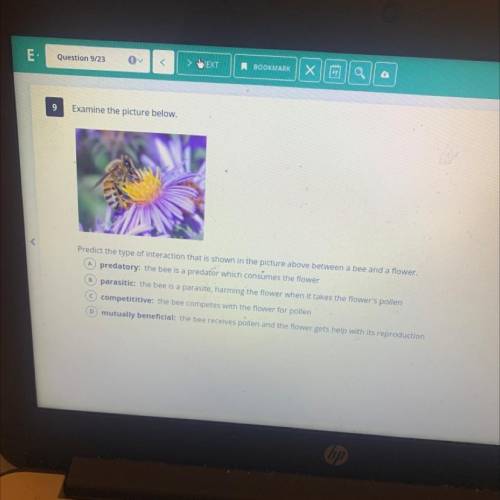
Biology, 06.05.2021 04:30 brummy309506
Examine the picture below.
Predict the type of interaction that is shown in the picture above between a bee and a flower
A ( predatory: the bee is a predator which consumes the flower
B( parasitic: the bee is a parasite, harming the flower when it takes the flower's pollen
C( competititive: the bee competes with the flower for pollen
Dmutually beneficial: the bee receives pollen and the flower gets help with its reproduction


Answers: 1


Other questions on the subject: Biology

Biology, 21.06.2019 13:00, vannia
What is the difference between self-pollination and cross-pollination? question 2 options: self-pollination leads to the creation of a fruit. cross-pollination does not. during cross-pollination, ovules are carried from one plant to another plant.. during self-pollination the ovules stay on the same plant. during cross-pollination, ovules are carried from one plant to another plant.. during self-pollination the ovules stay on the same plant. during cross-pollination the pollen grains are carried from one plant to another plant. during self-pollination the pollen and ovules are from the same plant. during cross-pollination, the pollen grains travel from the stigma to the anthers. during self-pollination, the pollen grains travel from the anthers to the stigma.
Answers: 1


Biology, 21.06.2019 22:00, tiffuuu
Im is in a crowd of people at the mall looking for his girlfriend tammy, who was supposed to meet him for dinner. jim realizes tammy is across the room as he catches a whiff of her overpowering perfume, 'paris #6'. which process explains why jim is able to smell the perfume?
Answers: 2

Biology, 22.06.2019 06:30, atiyawhite7863
Step 1 review the imaginary strand of dna below. note the complementary base pairs. a g c a a t c c g t c t t g g t c g t t a g g c a g a a c c step 2 to begin replicating this strand of dna, draw the two sides of the strand separating. step 3 now, draw the free-floating bases linking up with the separate sides. remember to follow the rules of complementary base pairing. step 4 draw the two resulting dna strands.
Answers: 1
You know the right answer?
Examine the picture below.
Predict the type of interaction that is shown in the picture above betw...
Questions in other subjects:

Biology, 28.07.2019 00:50






Health, 28.07.2019 00:50


Biology, 28.07.2019 00:50



